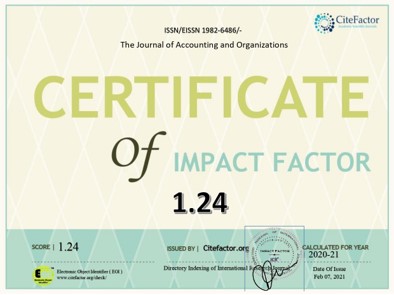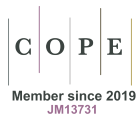Construtos de segunda ordem em modelagem de equações estruturais com mínimos quadrados parciais: como especificar, estimar e avaliar
DOI:
https://doi.org/10.11606/issn.1982-6486.rco.2023.201331Downloads
Referências
Aslam, W., & Luna, I. R. D. (2021). A relação entre as características da página de marcas no Facebook, valor percebido e comportamento de engajamento do cliente: aplicação da teoria do estímulo-organismo-resposta (SOR). Revista Brasileira de Gestão de Negócios, 23(1), 43-62. https://doi.org/10.7819/rbgn.v23i1.4092
Becker, J. M., Klein, K., & Wetzels, M. (2012). Formative hierarchical latent variable models in PLS-SEM: Recommendations and guidelines. Long Range Planning, 45(5-6), 359-94. https://doi.org/10.1016/j.lrp.2012.10.001
Becker, J. M., Cheah, J. H., Gholamzade, R., Ringle, C. M., & Sarstedt, M. (2022). PLS-SEM’s most wanted guidance. International Journal of Contemporary Hospitality Management, 35(1), 321-346. https://doi.org/10.1108/IJCHM-04-2022-0474
Campos, M. L., Moraes, G. H. S. M. de, & Spatti, A. C. (2021). Do University Ecosystems Impact Student's Entrepreneurial Behavior?. Brazilian Administration Review, 18(2), e200079. https://doi.org/10.1590/1807-7692bar2021200079
Cavalcanti, A. L., Felix, B., Mainardes, E. W. (2022). Do tensions lead to positive career satisfaction results? Revista de Administração Mackenzie, 23(3), eRAMR220200. Disponível em: https://doi.org/10.1590/1678-6971/eRAMR220200.en.
Cohen, J. (1988). Statistical power analysis for the behavioral sciences. Hillsdale, NJ: Lawrence Earlbaum Associates.
Crocetta, C., Antonucci, L., Cataldo, R., Galasso, R., Grassia, M. G., Lauro, C. N., & Marino, M. (2021). Higher-Order PLS-PM Approach for Different Types of Constructs. Social Indicators Resesarch, 154(2), 725-754. https://doi.org/10.1007/s11205-020-02563-w
Hair Jr., J. F., Hult, G. T. M., Ringle, C. M., & Sarstedt, M. (2017). A primer on partial least squares structural equation modeling (PLS-SEM) (2nd ed.). Thousand Oaks, CA: Sage.
Hair Jr., J. F., Hult, G. T. M., Ringle, C. M., & Sarstedt, M. (2022). A primer on partial least squares structural equation modeling (PLS-SEM) (3rd ed.). Thousand Oaks, CA: Sage.
Hair Jr., J. F., Hult, G. T. M., Ringle, C. M., Sarstedt, M., Danks, N. P., & Ray, S. (2021). Partial least squares structural equation modeling (PLS-SEM) using R. New York: Springer.
Hair, Jr., J. F., Sarstedt, M., Ringle, C. M., & Gudergan, S. P. (2018). Advanced issues in partial least squares structural equation modeling. Thousand Oaks, CA: Sage.
Hair, Jr., J. F., Sarstedt, M., Ringle, C. M., & Mena, J. A. (2012). An Assessment of the Use of Partial Least Squares Structural Equation Modeling in Marketing Research. Journal of the Academy of Marketing Science, 40(3), 414-433. https://doi.org/10.1007/s11747-011-0261-6
Hair, J. F., Ringle, C. M., & Sarstedt, M. (2011). PLS-SEM: Indeed a silver bullet. Journal of Marketing Theory and Practice, 19(2), 139-152. https://doi.org/10.2753/MTP1069-6679190202
Henseler, J., Ringle, C. M., & Sinkovics, R. R. (2009). The use of partial least squares path modeling in international marketing. In R. R. Sinkovics, & P. N. Ghauri (Eds.). Advances in International Marketing, vol. 20, (pp. 277-320). Bingley: Emerald.
Lacruz, A. J., Nossa, V., Lemos, K. R., & Guedes, T. de A. (2021). Mensurando a governança de organizações não governamentais: proposta de índice de governança. Contabilidade Vista & Revista, 32(3), 98-122. https://doi.org/10.22561/cvr.v32i3.6661
Lau, C. M., & Roopnarain, K. (2014). The effects of nonfinancial and financial measures on employee motivation to participate in target setting. The British Accounting Review, 46(3), 228-247. https://doi.org/10.1016/j.bar.2014.02.006
Lohmöoller, J. B. (1989). Latent Variable Path Modeling with Partial Least Squares. New York: Springer-Verlag.
Lopes, I. F., Meurer, A. M., & Voese, S. B. (2018). Efeito das Crenças de Autoeficácia no Comportamento Cidadão e Contraproducente dos Acadêmicos de Contabilidade. Advances in Scientific & Applied Accounting, 11(3), 517-531. http://dx.doi.org/10.14392/asaa.2018110309
Nicolaou, A. I., Sedatole, K. L., & Lankton, N. K. (2011). Integrated information systems and alliance partner trust. Contemporary Accounting Research, 28(3), 1018-1045. https://doi.org/10.1111/j.1911-3846.2011.01077.x
Pazetto, C. F., & Beuren, I. M. (2022). Sistemas de controle e identificação interorganizacional na cooperação em parques tecnológicos. Revista de Contabilidade e Finanças, 33(88), 13-28. https://doi.org/10.1590/1808-057x202113020
Ringle, C. M., Sarstedt, M., & Straub, D. W. (2012). Editor's Comments: A Critical Look at the Use of PLS-SEM in "MIS Quarterly", MIS Quarterly, 36(1), iii-xiv. https://doi.org/10.2307/41410402
Sanchez, G. (2013). PLS path modeling with R. Berkeley: Trowchez Editions.
Sarstedt, M., Hair Jr., J. F., Cheah, J.W., Becker, J.-M., & Ringle, C. M. (2019). How to specify, estimate, and validate higher-order constructs in PLS-SEM. Australian Marketing Journal, 27(3), 197-211. https://doi.org/10.1016/j.ausmj.2019.05.003
Sarstedt, M., Ringle, C. M., Cheah, J. H., Ting, H., Moisescu, O. I., & Radomir, L. (2020). Structural model robustness checks in PLS-SEM. Tourism Economics, 26(4), 531-554. https://doi.org/10.1177/1354816618823921
Sarstedt, M., Hair Jr., J. F., & Ringle, C. M. (2022). "PLS-SEM: indeed a silver bullet" - retrospective observations and recent advances. Journal of Marketing Theory and Practice. Advance online publication. https://doi.org/10.1080/10696679.2022.2056488
Sarstedt, M., Hair Jr., J. F., Pick, M., Liengaard, B. D., Radomir, L., & Ringle, C. M. (2022). Progress in partial least squares structural equation modeling use in marketing research in the last decade. Psychology & Marketing, 39(5), 1035-1064. https://doi.org/10.1002/mar.21640
Sarstedt, M., Radomir, L., Moisescu, O. I., & Ringle, C. M. (2022). Latent class analysis in PLS-SEM: A review and recommendations for future applications. Journal of Business Research, 138, 398-407. https://doi.org/10.1016/j.jbusres.2021.08.051
Schwaiger, M. (2004). Components and Parameters of Corporate Reputation: an empirical study. Schmalenbach Business Review, 56(1), 46-71. https://doi.org/10.1007/BF03396685
Trigueiro-Fernandes, L., Cavalcanti, J., Bila, M., & Moreno Añez, M. (2022). Escala de Componentes da Estrutura Organizacional (ECEO): Evidências de Validação de um Modelo Teórico. Brazilian Business Review, 19(3), 309-330. https://doi.org/10.15728/bbr.2022.19.3.5
Wetzels, M., Odekerken-Schröder, G., & Oppen, C. van. (2009). Using PLS path modeling for assessing hierarchical construct models: Guidelines and empirical illustration. Management Information Systems Quarterly, 33(1), 177-195. https://doi.org/10.2307/20650284
Wilson, B. (2010). Using PLS to investigate interaction effects between higher order branding constructs. In Vinzi, V. E., Chin, W.W., Henseler, & J., Wang, H. (Eds.). Handbook of Partial Least Squares: Concepts, Methods and Applications in Marketing and Related Fields (pp. 621-652). Berlin: Springer.
Downloads
Publicado
Edição
Seção
Licença
Copyright (c) 2023 Adonai Lacruz, Walter Macêdo de Assis, Thiago de Andrade Guedes

Este trabalho está licenciado sob uma licença Creative Commons Attribution-NonCommercial-NoDerivatives 4.0 International License.
A RCO adota a política de Acesso Livre (Libre Open Access), sob o acordo padrão Creative Commons (CC BY-NC-ND 4.0). O acordo prevê que:
- A submissão de texto autoriza sua publicação e implica compromisso de que o mesmo material não esteja sendo submetido a outro periódico. O original é considerado definitivo;
- Autores mantêm os direitos autorais e concedem à revista o direito de primeira publicação, com o trabalho simultaneamente licenciado sob a Licença Creative Commons Attributionque permite o compartilhamento do trabalho com reconhecimento da autoria e publicação inicial nesta revista;
- Autores têm autorização para assumir contratos adicionais separadamente, para distribuição não-exclusiva da versão do trabalho publicada nesta revista (ex.: publicar em repositório institucional ou como capítulo de livro), com necessário reconhecimento de autoria e publicação inicial nesta revista;
- Autores têm permissão e são estimulados a publicar e distribuir seu trabalho online (ex.: em repositórios institucionais ou na sua página pessoal) antes ou durante o processo editorial, já que isso pode gerar alterações produtivas, bem como aumentar o impacto e a citação do trabalho publicado (Veja O Efeito do Acesso Livre);
- A revista não paga direitos autorais aos autores dos textos publicados;
- O detentor dos direitos autorais da revista, exceto os já acordados no acordo de Libre Open Access (CC BY-NC-ND 4.0), é o Departamento de Contabilidade da Faculdade de Economia, Administração e Contabilidade de Ribeirão Preto da Universidade de São Paulo.
Não são cobradas taxas de submissão ou de publicação.
São aceitos até 4 autores por artigo. Casos excepcionais devidamente justificados poderão ser analisados pelo Comitê Executivo da RCO. São considerados casos excepcionais: projetos multi-institucionais; manuscritos resultantes da colaboração de grupos de pesquisa; ou que envolvam grandes equipes para coleta de evidências, construção de dados primários e experimentos comparados.
É recomendada a ordem de autoria por contribuição, de cada um dos indivíduos listados como autores, especialmente no desenho e planejamento do projeto de pesquisa, na obtenção ou análise e interpretação de dados e redação. Os autores devem declarar as efetivas contribuições de cada autor, preenchendo a carta ao editor, logo no início da submissão, responsabilizando-se pelas informações dadas.
É permitida a troca de autores durante todo o processo de avaliação e, antes da publicação do manuscrito. Os autores devem indicar a composição e ordem final de autoria no documento assinado por todos os envolvidos no aceite para publicação. Caso a composição e ordem de autoria seja diferente da informada anteriormente no sistema, todos autores anteriormente listados deverão se manifestar favoráveis.
No caso de identificação de autoria sem mérito ou contribuição (ghost, guest or gift authorship), a RCO segue o procedimento recomendado pela COPE.







